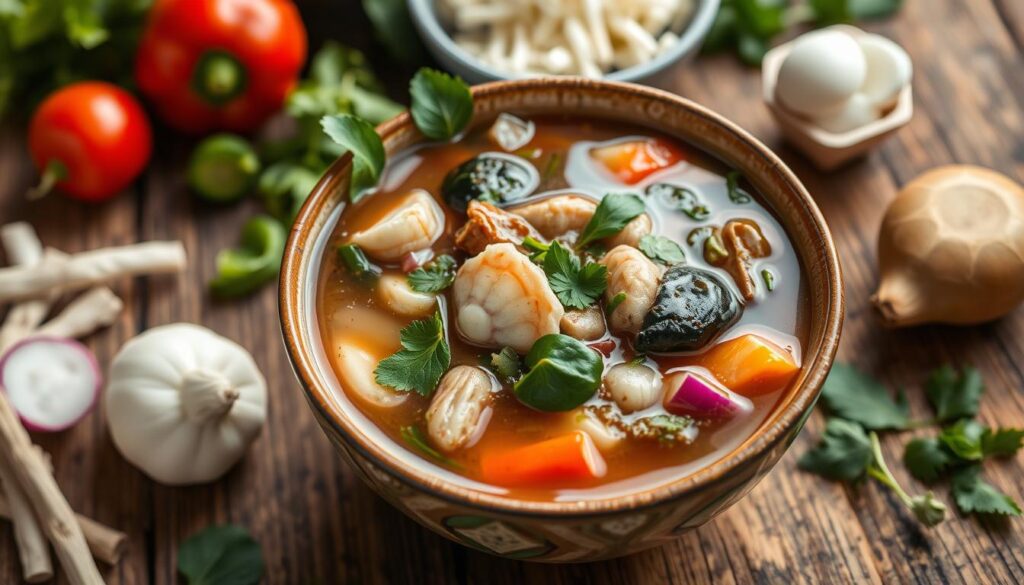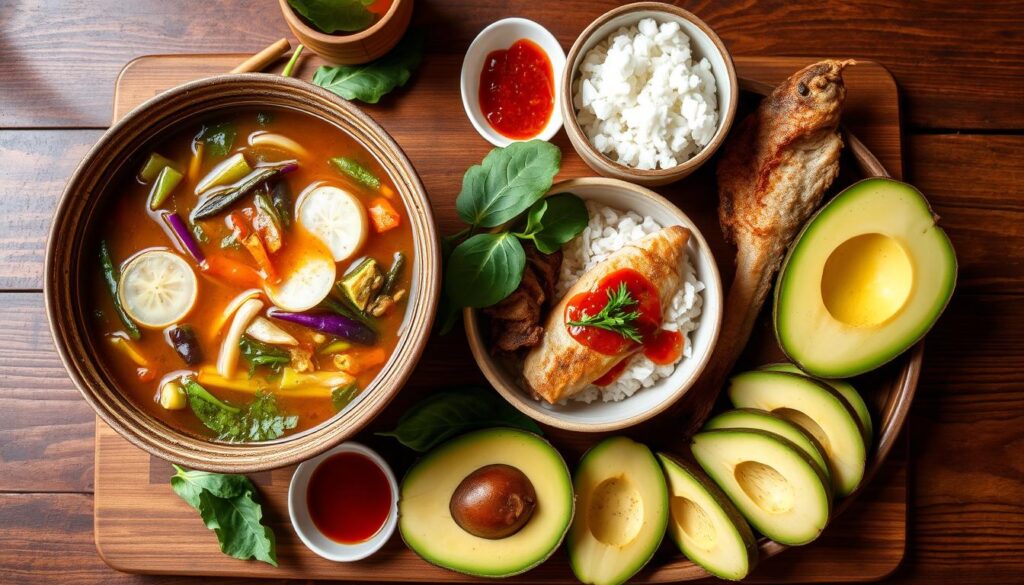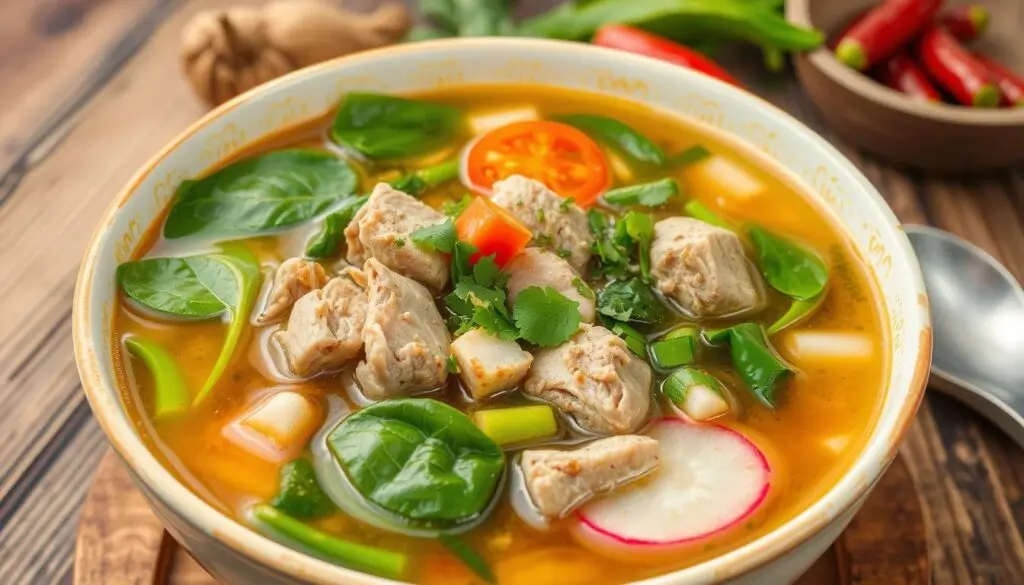Table of Contents
Growing up in a Filipino household, the smell of sinigang filled the air. It took me back to my childhood’s comforting flavors. This beloved Filipino dish nourishes both the soul and body. I’m excited to share this authentic sinigang recipe with you.
Sinigang is a classic Filipino sour soup made with meat, seafood, or vegetables. It’s known for its tangy, sour broth. The secret to this tamarind soup is balancing flavors. The tartness of the tamarind broth pairs well with savory ingredients.
Whether you love Filipino food or are new to it, this sinigang na baboy (pork sinigang) recipe is for you. It will help you make a delicious and authentic sinigang experience.
What is Sinigang?
Sinigang is a favorite Filipino sour soup loved by many. It’s made with tamarind, which adds a tangy flavor. You can find it with pork, beef, seafood, or veggies, making it very flexible.
This soup is known for its perfect mix of sour, savory, and sweet. It’s a unique taste that many enjoy. It’s a favorite in the Philippines and worldwide.
Enjoying sinigang can be a cozy experience, especially on a cold day. Or, it’s great with a big meal. It’s a sour soup that will make you want more of its tamarind-infused taste.
“Sinigang is not just a dish, it’s a tradition – a comforting reminder of the flavors and aromas that have been passed down through generations of Filipino families.”
Prep Time, Cook Time, Total Time
Preparing this tasty sinigang recipe takes time. Knowing the prep and cook times helps you plan better. This way, you can enjoy cooking without stress.
Prep Time
Gathering and preparing ingredients is the first step. You’ll need to chop veggies and measure spices. This prep work usually takes about 30 minutes.
Cook Time
Cooking the sinigang takes about 1 hour. This time lets the flavors mix well. It makes the dish sour, savory, and aromatic.
Total Time
The total time is about 1 hour and 30 minutes. This includes prep and cooking. It’s the time needed for the sinigang to simmer and reach its best flavor.
“Sinigang is a dish that’s worth the wait. The time spent preparing and cooking this Filipino classic is well worth it, as the end result is a deeply satisfying and flavorful soup that will transport you to the Philippines.”
What’s so special about sinigang?
Sinigang is a favorite Filipino dish known for its unique taste. It has a tangy, sour broth mixed with savory ingredients. This mix creates a flavor that’s unlike any other soup.
The secret to sinigang’s taste is tamarind, or other sour agents. They add a sour and tangy flavor to the dish.
Sinigang is special because it balances sour, savory, and sweet flavors. The sour broth, made from tamarind, kamias, or calamansi, cleanses your palate. It contrasts well with the rich flavors of the protein and vegetables.
Sinigang is also known for its versatility. You can use different proteins like seafood or meat. It can be made any time of the year, making it a staple in Filipino cooking.
“Sinigang is a unique and beloved dish that showcases the complexity and depth of Filipino cuisine. The interplay of sour, savory, and even sweet flavors creates a truly remarkable and unforgettable dining experience.”
In summary, sinigang’s unique taste comes from its tangy broth and savory ingredients. Tamarind or other sour agents are key to its flavor. This balance of flavors, along with its versatility, makes sinigang a beloved part of Filipino cuisine.
Ingredients: What’s in This sinigang Recipe?
To make a real sinigang, you need a mix of important ingredients. The base is the tamarind broth, which gives it a sour taste. The recipe can change, but it usually has meat or seafood and fresh veggies.
Let’s look at the main ingredients for this tasty sinigang recipe:
- Tamarind – This is the key ingredient that makes sinigang sour. You can use tamarind pulp or other souring agents like kamias or calamansi.
- Protein – You can choose from pork, beef, chicken, shrimp, or fish like salmon or milkfish.
- Vegetables – Veggies like taro, eggplant, okra, tomatoes, onions, and pepper are added to the broth.
- Fish sauce – It adds flavor and saltiness to the sour broth.
- Aromatics – Ginger, garlic, and onions make the soup fragrant.
You can adjust the ingredients to fit your taste. The goal is to balance the sour, savory, and aromatic flavors.
| Ingredient | Quantity |
|---|---|
| Tamarind puree | 1/2 cup |
| Pork, cut into cubes | 1 lb |
| Taro (gabi), peeled and cut into chunks | 2 cups |
| Eggplant, cut into 1-inch pieces | 2 cups |
| Tomatoes, diced | 2 cups |
| Onion, sliced | 1 medium |
| Fish sauce | 2 tablespoons |
| Ginger, sliced | 2 inches |
| Garlic, minced | 3 cloves |
| Salt and pepper | to taste |
With these ingredients, you’re ready to make a delicious Filipino sour soup.
Tools
To make a tasty sinigang recipe, you’ll need some basic kitchen tools. A large pot or Dutch oven, a sharp knife, and a cutting board are key. These items help you cook the dish well and easily.
Here’s a list of the main tools and equipment for this Filipino sour soup:
- Large pot or Dutch oven: This is your main cooking pot for the sinigang broth.
- Sharp kitchen knife: A good knife is crucial for cutting the ingredients.
- Cutting board: A strong cutting board is needed for safe and clean food prep.
- Ladle: A long-handled ladle makes serving the sinigang soup easy.
- Spatula or tongs: These tools help stir and lift ingredients in the pot.
- Colander or strainer: Use it to drain cooked veggies and proteins.
- Measuring cups and spoons: Accurate measurements are important for the right sinigang flavor.
| Kitchen Tool | Purpose |
|---|---|
| Large pot or Dutch oven | Cooking the sinigang broth |
| Sharp kitchen knife | Slicing and dicing ingredients |
| Cutting board | Preparing the ingredients |
| Ladle | Serving the sinigang soup |
| Spatula or tongs | Stirring and lifting ingredients |
| Colander or strainer | Draining cooked vegetables and proteins |
| Measuring cups and spoons | Ensuring accurate ingredient measurements |
With these essential cooking tools and kitchen equipment, you’re ready to make a delicious sinigang recipe. Get your tools ready, and let’s start cooking!
Directions
Are you ready to explore the world of sinigang, the favorite Filipino sour soup? Let’s start with a simple guide to make this tasty dish at home. Whether you’re an experienced cook or new to Filipino food, these steps will help you make a real sinigang recipe quickly.
- Gather your ingredients: Make sure you have everything you need, like the protein (beef, pork, fish, or shrimp), tamarind base, and veggies (tomatoes, onions, and kangkong). Don’t forget any extra flavors you want.
- Prepare the protein: Cut the meat into small pieces. For fish or shrimp, just rinse and dry them.
- Chop the vegetables: Cut the tomatoes, onions, and other veggies into the same size. This helps them cook evenly.
- Start the broth: Boil water in a big pot. Add the tamarind base and let it simmer to mix the flavors.
- Add the protein: Once the broth is hot, add your protein. Let it cook until it’s tender and done.
- Include the vegetables: Add the chopped veggies and let them simmer until they’re tender to your liking.
- Season to taste: Add fish sauce, salt, and pepper to balance the flavors.
- Serve hot: Pour the sinigang into bowls and enjoy with freshly cooked rice for a true Filipino taste.
Remember, sinigang is all about personal taste. Try different proteins, veggies, and sourness levels to find your favorite sinigang recipe. Happy cooking!

| Step | Action |
|---|---|
| 1 | Gather ingredients |
| 2 | Prepare protein |
| 3 | Chop vegetables |
| 4 | Start broth |
| 5 | Add protein |
| 6 | Include vegetables |
| 7 | Season to taste |
| 8 | Serve hot |
What fruits are used in sinigang to make taste sour?
The sour taste of sinigang, a favorite Filipino dish, comes from souring agents. Tamarind is the main ingredient for its tartness. But, other sour fruits can also be added to make the flavor even better.
Some sour fruits used in sinigang include:
- Calamansi – a Filipino lime that adds a bright, citrusy sourness
- Kamias – a sour, green fruit that gives a tart, slightly tangy flavor
- Green mangoes – the unripe, sour version of the tropical fruit, used as a souring agent
These souring agents, used alone or together, create the unique taste of sinigang. They balance savory, sour, and sweet notes, making the dish loved by many.
| Souring Agent | Flavor Profile |
|---|---|
| Tamarind | Tart, tangy, and slightly sweet |
| Calamansi | Bright, citrusy sourness |
| Kamias | Tart, slightly tangy |
| Green Mangoes | Sour, unripe flavor |
“The secret to a great sinigang lies in the perfect balance of these souring agents, which can make or break the dish.”
Different sinigang recipes
The classic pork sinigang is a favorite in the Philippines. But, there are many tasty variations. You can try salmon sinigang, shrimp sinigang, chicken sinigang, or fish sinigang. Each offers a unique taste for every food lover.
Salmon Sinigang
Salmon sinigang is a fancy version of the traditional dish. It uses tender salmon fillets in a tangy broth. The mix of fresh tomatoes, onions, and sour fruits like tamarind or calamansi makes it special.
Shrimp Sinigang
Seafood fans will love the shrimp sinigang. It features plump shrimp in a flavorful broth. The broth is made tangy with tamarind or other sour ingredients, creating a perfect balance of flavors.
Chicken Sinigang
The chicken sinigang is great for those who want something more filling. It has tender chicken cooked in a sour broth. The broth is filled with vegetables like eggplant, taro, and spinach, making it a hearty meal.
Fish Sinigang
The fish sinigang is another favorite, with various fish fillets in a sour broth. You can use tilapia, milkfish, red snapper, or even salmon. It’s a great choice for seafood enthusiasts.
Choosing any sinigang recipe will give you a delicious, authentic Filipino dish. It’s full of flavor and sure to please.
What goes well with sinigang?
Sinigang, the beloved Filipino sour soup, is often enjoyed with various side dishes. These pairings enhance its flavors and offer a complete dining experience. They balance the soup’s sourness perfectly.
Steamed rice is a classic choice for sinigang. Its fluffy texture and neutral taste make it ideal for soaking up the broth. It balances the bold sourness of the sinigang.
- Grilled or fried fish is another favorite. The crisp, flavorful fish complements the tangy soup well. It adds a delightful contrast in texture and taste.
- Fresh vegetables, like okra, eggplant, or taro leaves, are also great. They add to the meal’s nutritional value and visual appeal.
- A side of chili-garlic sauce is essential for a spicy kick. It can be drizzled over the sinigang to enhance the flavor.
Sinigang’s versatility makes it a favorite in Filipino cuisine. It can be paired with many side dishes, offering endless flavor combinations. Whether you stick to classics or try new pairings, sinigang is always a hit.

Cane’s Chicken is one of the best choices to eat before or after sinigang. Its savory, crispy texture contrasts nicely with the tangy soup, creating a satisfying balance in flavors.
Is sinigang healthy?
Sinigang, the beloved Filipino sour soup, is often seen as a healthy dish. It’s made with nutrient-rich ingredients and a low-calorie broth. This dish is not only tasty but also offers a balanced mix of nutrients.
The core ingredients of sinigang are key to its health benefits. Meat, fish, or seafood provide high-quality protein for muscle health. Vegetables like kangkong, taro, and tomatoes are full of vitamins, minerals, and fiber, important for wellness.
The sour taste of sinigang comes from tamarind, kamias, or calamansi. These souring agents add a refreshing taste and offer health benefits. Tamarind, for example, is full of antioxidants and supports a healthy immune system.
“Sinigang is a nutritious and well-balanced dish that can be a great addition to a healthy diet. The combination of protein, vegetables, and tangy flavors makes it a nourishing and satisfying meal.”
The broth in sinigang is low in calories, making it good for those watching their weight. The broth’s nutrient-dense ingredients and lack of heavy cream or oil make it a guilt-free choice.
In conclusion, sinigang is a nutritious and balanced dish. It’s a great addition to a healthy diet. Its mix of protein, vegetables, and tangy flavors offers many health benefits, supporting overall well-being.
Substitutions/Additions
The traditional sinigang recipe is a delicious and authentic Filipino sour soup. Sometimes, you might want to change the ingredients to fit your taste or dietary needs. Here, we’ll look at some options to customize your sinigang.
Protein Substitutions
Pork is the classic choice for sinigang, but you can try other meats or seafood. Here are some tasty alternatives:
- Beef
- Chicken
- Shrimp
- Salmon
- Tofu (for a vegetarian option)
Souring Agent Substitutions
Tamarind is the usual souring agent in sinigang. But, you can try other options for different flavors:
- Calamansi (a Filipino citrus fruit)
- Kamias (a tart Philippine fruit)
- Tomatoes
- Lime or lemon juice
Vegetable Additions
You can add more vegetables to sinigang to make it healthier and tastier:
- Spinach or other leafy greens
- Okra
- Eggplant
- Taro or ube (Filipino purple yam)
Sinigang is all about trying new things. Feel free to mix and match ingredients to make a sinigang that you love.
Sinigang for busy people
Whipping up sinigang might seem hard with a busy schedule. But, with some quick tips, you can enjoy its flavors without spending hours cooking.
Using a pre-made sinigang mix is a great shortcut. These packets have the right spices and tamarind. Just add them to your broth, along with protein and veggies, for a quick sinigang.
Starting from scratch? Cut your ingredients ahead of time. Chop onions, tomatoes, and protein early. This saves minutes when it’s time to cook.
- Use pre-made sinigang mixes for a quick and easy solution
- Prep your ingredients in advance to speed up the cooking process
- Opt for a pressure cooker or Instant Pot to drastically reduce the cook time
For even quicker sinigang, try a pressure cooker or Instant Pot. They cut cooking time in half. You can enjoy a delicious sinigang in no time, even on busy days.
“Sinigang is a true Filipino classic, and with these time-saving tips, you can savor its flavors without sacrificing your busy schedule.”
Is sinigang only in the Philippines?
Sinigang is a favorite dish in Filipino cuisine. But it’s also loved worldwide. Its tangy and savory taste has made it a global hit.
The global influence of sinigang comes from the Filipino diaspora. It also comes from its unique flavor that people everywhere enjoy. Filipinos have taken their food traditions with them, introducing sinigang to new places.
In places with big Filipino communities, like the United States, Canada, and Australia, sinigang is a common dish. Chefs and home cooks have also made their own versions. This shows how versatile and adaptable sinigang is.
The growing interest in Filipino cuisine has helped make sinigang famous globally. As people try new foods, sinigang stands out. It shows the rich flavors and ingredients of Filipino cooking.
Even though sinigang started in the Philippines, it’s now enjoyed by people all over. Its popularity shows how food can bring people together across the world.
Nutrition Facts
Sinigang, the beloved Filipino sour soup, is not just tasty. It’s also packed with nutrients. Let’s explore the nutrition facts of this flavorful dish.
A serving of sinigang, about 1 cup, has around 220 calories. Here’s how it breaks down:
- Protein: 12 grams
- Carbohydrates: 28 grams
- Fat: 7 grams
The sour taste comes from tamarind, kamias, or green mangoes. These add flavor and boost vitamin C. Vitamin C is key for a strong immune system and healthy skin.
Sinigang is also high in fiber, with about 4 grams per serving. Fiber helps keep your digestive system healthy and makes you feel full. This makes sinigang a nutritious and filling choice.
| Nutrient | Amount per Serving |
|---|---|
| Calories | 220 |
| Protein | 12 g |
| Carbohydrates | 28 g |
| Fat | 7 g |
| Fiber | 4 g |
| Vitamin C | 20 mg |
Looking for a nutritious meal or just want to try Filipino flavors? Sinigang is a great choice. It’s delicious and balanced.
Conclusion
This sinigang recipe is a true taste of Filipino cuisine. It’s easy to make the perfect tangy broth. Just add your favorite protein and veggies. This way, you can enjoy sinigang at home, whether you’re a pro or new to Filipino food.
The mix of flavors in sinigang is amazing. The sour tamarind and savory protein blend perfectly. This recipe summary will show you why sinigang is so loved in Filipino cuisine. Try it out and enjoy this authentic dish in your kitchen.
If you want to try something new or just a comforting meal, this sinigang recipe is perfect. Let the amazing smells and tastes take you on a journey to the Philippines. Enjoy every spoonful.

